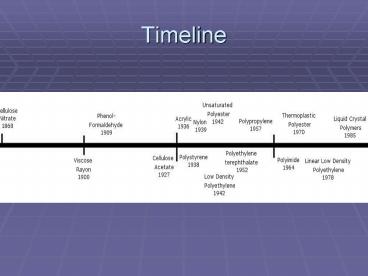Timeline - PowerPoint PPT Presentation
1 / 33
Title:
Timeline
Description:
Invented Neoprene and Nylon. Nylons. Condensates of aliphatic diacids with aliphatic diamines ... after the war (the infamous Nylon riots of 1946) Nylon 66 ... – PowerPoint PPT presentation
Number of Views:1038
Avg rating:3.0/5.0
Title: Timeline
1
Timeline
2
Definition
- Plastic is broadly defined as
- Any inherently formless material that can be
molded or modeled under heat or pressure
3
As early as
- Go back as far as the Old Testament
- References of
- Fillers
- Adhesives
- Coatings
4
Good Ol Enoch Noyes
- 1760
- Opened business with the use of natural polymers
- Made combs out of organic proteins (Keratin and
Albuminiod) derived from animal horns, hoofs, an
tortoise shells
5
In the beginning
- Greek word plastikos
- First natural plastics
- Tortoise shell
- Tree resins
- Shellac
- Insect secretion
6
Natural Rubber
- Natural rubber mainly polyisopropene
- Tends to be sticky when hot, brittle when warm
- Does not reform when stretched
7
Natural Rubber
Charles Goodyear, 1839 Oven cleaning
- Natural rubber mainly polyisopropene
- Tends to be sticky when hot, brittle when warm
- Does not reform when stretched
8
Ebonite bracelet from 1880
1851 Hard Rubber 20-30 Sulfur
9
Christian Schoenbine
- Swiss Chemist
- 1840s
- Developed Cellulose nitrate
- Mix of cotton (wifes apron), nitric acid, and
sulfuric acid
Early Films Highly flammable and explosive
10
Parkes Invents Celluloid
- The first man-made plastic was unveiled by
Alexander Parkes at the 1862 Great International
Exhibition in London. - Parkesine- organic material derived from
cellulose that could be molded in heat and retain
its shaped when cooled - Buttons
- Combs
- Pens
11
Alexander Parkes- 1855
- Rights sold to Daniel Spill (1865)
- Patented
- Downfall- high cost of the raw materials needed
in its production.
12
John Wesley Hyatt
- Billiard Co. in U.S.
- Needed substitute for ivory in making balls
- John Wesley Hyatt developed collodion
- Upon spilling a bottle of collodion in his
workshop, he discovered that the material
congealed into a tough, flexible film - Camphor and cellulose nitrate
- Occasional Explosion upon impact
Formed the American Celluloid Company which is
today the Plastics Division of the Celanese
Corporation
13
Bakelite
- Dr. Leo Baekeland
- First totally synthetic plastic (1907)
- Didnt throw away his foul glassware
- Patented in 1909
- Thermoset resin
- Replaced rubber for insulation in electrics
14
Bakelite
15
Bakelite
- Phenol-formaldehyde resins which he called
Bakelite.
16
Polyvinyl Chloride (PVC)
- PVC was first created by the German chemist Eugen
Baumann in 1872. - Patented in 1913
- Waldo L. Semon, invented a way to make polyvinyl
chloride (PVC) useful
17
Polyvinyl Chloride (PVC)
18
Applications of PVC
19
Applications of PVC
plasticizers
20
Polymerization
- In 1920, German Hermann Staudinger published
theories on polyaddition - Nine year later published the polymerization of
polystyrene.
21
Polystyrene
- Dow Chemical brought polystyrene to the U.S. in
1937
Toy shark, in Polystyrene, with moving jaw, Made
in USA around 1950
- Merrifield resins
22
Styrofoam
- Foam egg cartons, burger containers, coffee cups
, "peanuts" used in packing and the lightweight
foam pieces that cushion new appliances and
electronics. - Gas is blown in during the polymerization-- 95
of styrofoam is air (try dissolving in acetone) - CFCs were used until the 80s phased out and
replaced with pentane or CO2
Polystyrene up close
23
Dr. Wallace H. Carothers
- 1930s research on polymer chains at DuPont
Chemical Department - Invented Neoprene and Nylon
24
Nylons
- Condensates of aliphatic diacids with aliphatic
diamines - Introduced in the 1939 Worlds Fair
- Nylonmania interrupted during WWII, but resumed
after the war (the infamous Nylon riots of 1946)
Nylon 66
co-crystalline
Fibers are spun (showerhead)
25
Synthetic Rubbers
Gasoline pump hoses, Hoses for automobile engines
Styrene/Butadiene copolymer (SBR) is the most
important synthetic rubber, and was the first
and most widely produced rubber of WWII
26
Plexiglass anionic polymerization
Windshields, plastic coatings, hard and soft
contact lenses
27
Ok, but how can I make a leisure suit
- Polyesters
Dacron
28
Teflon
- Teflon
- Polytetrafluoroethylene (PTFE)
- Dupont Chemical Department
- First used for artillery shell covers
29
World War II
- Polyethylene (1933)
- Imperial Chemical Industries in England
- E.W. Fawcett R.O. Gibson
- First used for underwater cable coatings and
insulation for radar
30
Polyethylene
- 1943 Karl Ziegler changed polymerization of
polyethylene - Use of catalysts
- Now is most widely produced and perhaps most
versatile plastic
31
Polypropylene
- Guilio Natta continued Zieglers work
- Created polypropylene in 1957
- Substituted for polyethylene where high
temperatures were involved - Ex. Dishwasher safe dishes
Cars front bumper made of polypropylene in 1978
32
Stereochemistry and Polymer Properties
Isotactic fabrics for carpets, automobile parts,
battery casings, medicine
bottles Syndiotactic new applications are
emerging Atactic soft, and not very useful
33
Relevant Additional Links
- History of Plastic and Leo Bakeland
- inventors.about.com/library/inventors/blplastic.ht
m - History of Plastics
- www.lle.mdx.ac.uk/site/docs/dt/Historyofplastics.h
tml - About Plastics
- www.americanplasticscouncil.org/benefits/about_pla
stics/history.html































